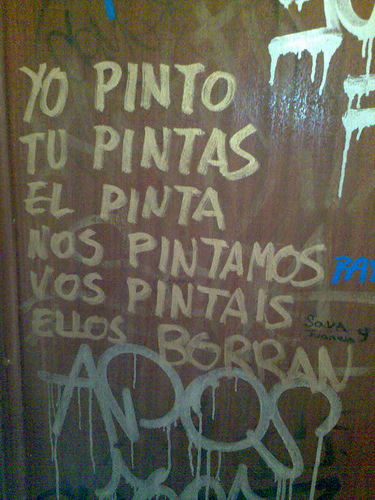 |
| Colloquialism is indispensable |
| Photo credit: Visentico/Sento licensed CC BY-SA 2.0 |
How you wish to sound is up to you but if natural, native Spanish is your dream, you cannot and must not escape colloquialism. And no, Latinos are sweet people and won’t crucify you if you speak Spanish as taught in the books. But if you could pull off authentic, colloquial Spanish with calculated caution, you will surely be a step closer to the inner-circle of native-speakers!
Greetings in street Spanish
This is but a very, very small subset of some of the most commonly phrases used by native speakers while greeting each other. Depending on which part of the world you are in, you might find some phrases used more heavily than others. No blog or book can teach you such intricacies and native speakers are the best teachers when it comes to street Spanish, but knowledge of some of the more ubiquitous colloquialisms could prove a good starting-point.
 |
| One of the many colloquial greetings in Spanish |
| Pphoto credit: Stevenson O'Connor licensed CC BY-SA 2.0 |
How are you? – ¿Cómo andas? / ¿Qué onda? (Mexican slang)
How’s it going? – ¿Cómo te va?
How’s everything? – ¿Cómo te va todo?
How’s life? – ¿Cómo te va la vida?
What’s up? – ¿Qué tal andas?
What’s going on? – ¿Qué pasa? / ¿Qué hay?
What’s new? – ¿Qué hay de nuevo? / ¿Qué me cuentas?
Colloquial responses to greetings in street Spanish
If there can be a colloquial way to greet, there’s got to be a colloquial way to respond once greeted, isn’t it? Here's a list of some of the most ubiquitous responses to common greetings heard and understood in almost every corner of the Spanish-speaking world. Rest assured, you can’t go wrong with them.
Same as ever – Como siempre / Aquí estamos / Aquí andamos
Awesome! – ¡Genial! / ¡Fenomenal! / ¡De maravilla!
Awful! – ¡Fatal! / ¡De pena!
Everything’s good! – ¡Todo va bien !
Can’t complain! – ¡No me quejo!
Getting by – Tirando
It is what it is – Es lo que hay
Not great – Vaya, no muy bien
Leave me alone! – ¡Déjame en paz!
I’m in an awful mood – Vengo encabronado
Feel like scouring the streets?
 |
| Local streets are goldmines of colloquial Spanish |
| Photo credit: Katrin Lorenzen licensed CC BY-SA 2.0 |
So, go out, venture into Hispanic neighborhoods (if your city has one) or make Spanish-speaking friends on the Internet, and use them as some of the best resources a Spanish-enthusiast could ever afford! When you are starting out learning Spanish, it is very important that you ask questions. Be careful and understand every new slang thoroughly with more than enough context and examples before you actually decide to incorporate them into your speech. Depending on where you are, words can have a very subtle and inherent undertone which often cannot be expressed by dictionaries and thesauruses. While the dictionary can tell you that a word is “bad” or non-standard, or slang, you need to know, understand, and appreciate “how bad” it is in the real world. Why? Because that is the only way for you to know what contexts are best suited for the word in question without taking away from the originally intended meaning and sense. While learning Spanish, you must appreciate that any word, phrase, or sentence can have several shades of the same central theme depending on where it’s spoken and even on who is speaking. Whatever you do, please do not rely blindly on what that touristic-looking pocket phrasebook would have you believe. The Spanish of the books is, more often than not, clichéd and unlike what you are likely to hear in real barrios (neighborhoods) and aldeas (villages).
Please feel free to drop in your comments if you found this post any bit useful. And, if at all you happen to be a native speaker, everyone including me would love to benefit from your experience. Just add in any colloquialism that could add value to this collection as I am sure there is as much diversity in Spanish colloquialism as there are regions with Spanish as their primary language!












.png)
I can not find where to learn how to pronounce the ABC's in Mexican/Spanish.
ReplyDeleteDo you mean the Spanish phonetic alphabet, such as A de Antonio, B de Barcelona, etc.? Try this link: http://en.wiktionary.org/wiki/Appendix:Spanish_phonetic_alphabet
ReplyDeleteIf, however, you just want to learn what the letters are called in Spanish, such as A (ah), B (beh), C (ceh), etc., follow this link: http://www.omniglot.com/writing/spanish.htm
Hope this helps. Salud!